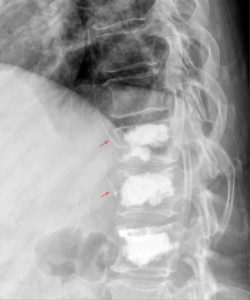
A kyphoplasty procedure uses a balloon, which is inserted into the damaged vertebrae and inflated to restore the compressed vertebrae to its original height. Once the vertebrae is restored to its original height, the balloon is removed, and bone cement will fill the space left by the balloon.
What is it?
A kyphoplasty aims to treat spinal fractures caused by a variety of injuries, including osteoporosis, malignant tumors, and elderly patients with impaired bone healing. Much like a vertebroplasty, bone cement is injected into the spine to stabilize vertebral fractures. In a kyphoplasty, a balloon is used to inflate the damaged area and restore the vertebrae to its original condition before injecting the cement. Stabilization of fractures will restore spinal function and reduce pain.
What should I do to prepare?
When preparing for a kyphoplasty appointment, it is important to avoid eating for eight hours prior. You are allowed to drink clear liquids before the procedure, but it is important to avoid drinking orange juice, milk, or cream. If you are taking anti-coagulants, you will need to talk to your doctor before the appointment to discuss further use.
What happens during the process?
The patient lies face down on the procedure table and is given IV sedation as well as a local numbing anesthetic. A small incision in the back is made, and a thin tube is threaded through the incision. Using fluoroscopic guidance, the tube is guided down to the damaged portion of the spine. Using x-ray imaging, the surgeon inserts a small balloon down through the tube and carefully inflates it, elevating the fracture and bringing the vertebrate back to its normal position. The balloon is then carefully removed, and bone cement is injected to fill the empty cavity left by the balloon. The cement quickly hardens, stabilizing the fracture.
What are the risks and potential complications?
As with all general surgeries, risks such as allergic reactions to anesthesia and infection apply. Other complications of a kyphoplasty include spinal cord or nerve damage, nerve injury or spinal cord compression, and allergic reactions to the visualization chemicals used.
Disclaimer:
All GlobeHealer Site content, including graphics, images, logos, and text, among other materials on the site are for educational purposes only. This content is not intended to be a substitute for professional medical advice, and you should always contact your physician or qualified health provider for information regarding your health. Information on this site regarding the overview, diagnosis, and treatment of any kind should be looked at, in addition to the advice and information of your health care professional. Do not disregard medical advice or delay seeking treatment or medical advice due to information found on the GlobeHealer site.
If there is even the possibility that you may have a medical emergency, seek treatment, call your doctor, or call your local emergency telephone number immediately. GlobeHealer does not endorse being the first line of communication in case of emergency and does not endorse any specific test, physician, facility, product, procedure, opinion, or other information that is or may be mentioned on this site or affiliated entities. Reliance of any and all information provided by GlobeHealer, its employees, affiliations, others appearing on the Site under the invitation of GlobeHealer, or visitors of the site is solely at your own risk and is not the responsibility of GlobeHealer.
Image Source: https://upload.wikimedia.org/wikipedia/commons/6/69/Zementaustritt_nach_Kyphoplastie_77jw_-_Roe_-_001.jpg
